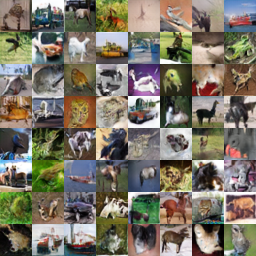minhnhat93 / Tf Sndcgan
Programming Languages
Projects that are alternatives of or similar to Tf Sndcgan
tf-SNDCGAN
Tensorflow implementation of the paper "Spectral Normalization for Generative Adversarial Networks" (https://www.researchgate.net/publication/318572189_Spectral_Normalization_for_Generative_Adversarial_Networks, ICML 2017)
The implementation is based on the author's original code at: https://github.com/pfnet-research/chainer-gan-lib
This implementation works for tensorflow default data format "NHWC"
Spectral Normalization for Generative Adversarial Networks:
This method enforces Lipschitz-1 condition on the Discrminator of Wasserstein-GAN by normalizing its weight matrices with their own respective maximum singular value. This can be used together with Gradient Penalty in the paper "Improved Training of Wasserstein GAN".
The author uses a fast approximation method to compute the maximum singular value of weight matrices.
Quick run:
Keras is required for loading Cifar10 data set
python3 train.py
How to use spectral normalization:
# Import spectral norm wrapper
from libs.sn import spectral_normed_weight
# Create weight variable
W = tf.Variable(np.random.normal(size=[784, 10], scale=0.02), name='W', dtype=tf.float32)
# name of tf collection used for storing the update ops (u)
SPECTRAL_NORM_UPDATE_OPS = "spectral_norm_update_ops"
# call wrapping function, W_bar will be the spectral normed weight matrix
W_bar = spectral_normed_weight(W, num_iters=1, update_collection=SPECTRAL_NORM_UPDATE_OPS)
# Get the update ops
spectral_norm_update_ops = tf.get_collection(SPECTRAL_NORM_UPDATE_OPS)
...
# During training, run the update ops at the end of the iteration
for iter in range(max_iters):
# Training goes here
...
# Update ops at the end
for update_op in spectral_norm_update_ops:
sess.run(update_op)
For an example, see the file test_sn_implementation.py
Training curve:
Generated image samples on Cifar10:
Inception score:
After using in place batch norm update and use the optimal training parameters from the paper, I was able to match their claimed Inception score at 100k iteration: 7.4055686 +/- 0.087728456
The official github repostiory has an inception score of 7.41
Issues:
-
GPU under-utilization: The original implementation of the author in chainer uses 80%+ GPU most of the time. On an NVIDIA GTX 1080TI, their implementation run at nearly 3 iterations/s. This implementation use less than 50% GPU and run at less than 2 iterations/s.Solved. It was the global_step assignment that makes tensorflow create new assign node for graph each iteration, slow down the execution. This also made the graph become very large over time leading to gigantic event files. GPU utilization is now around 85+% -
No Fréchet Inception Distance (https://arxiv.org/abs/1706.08500) evaluation yet.


